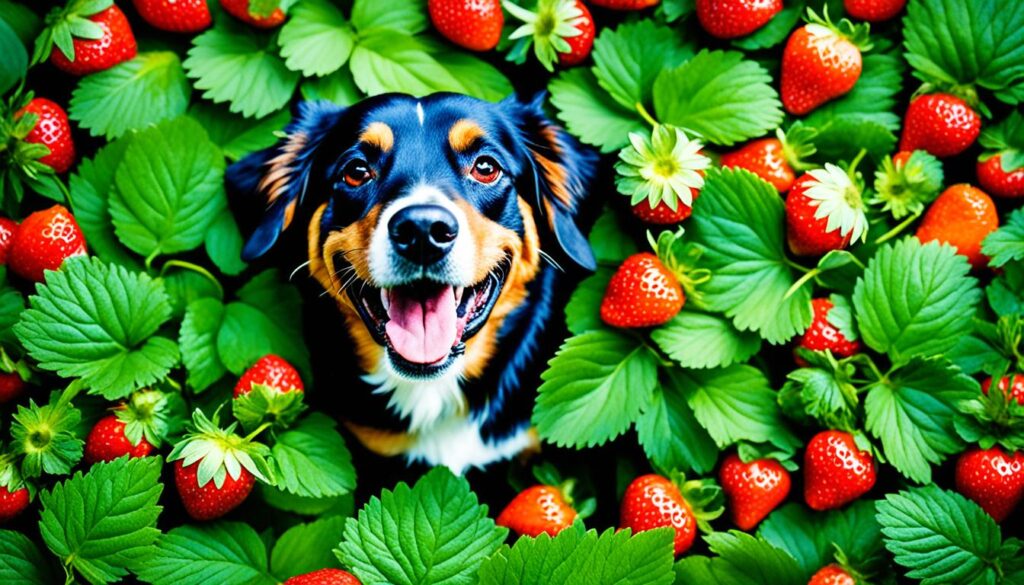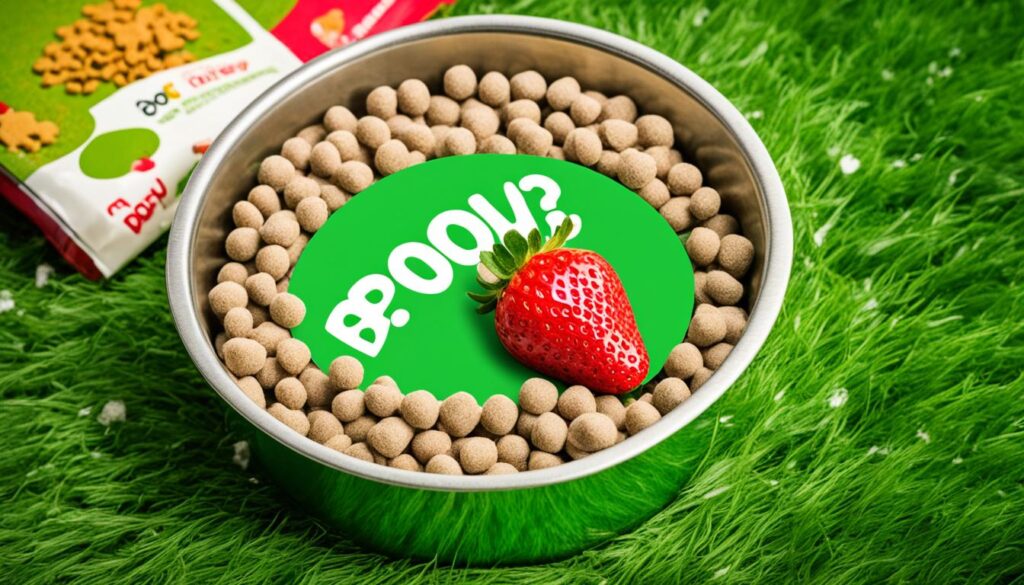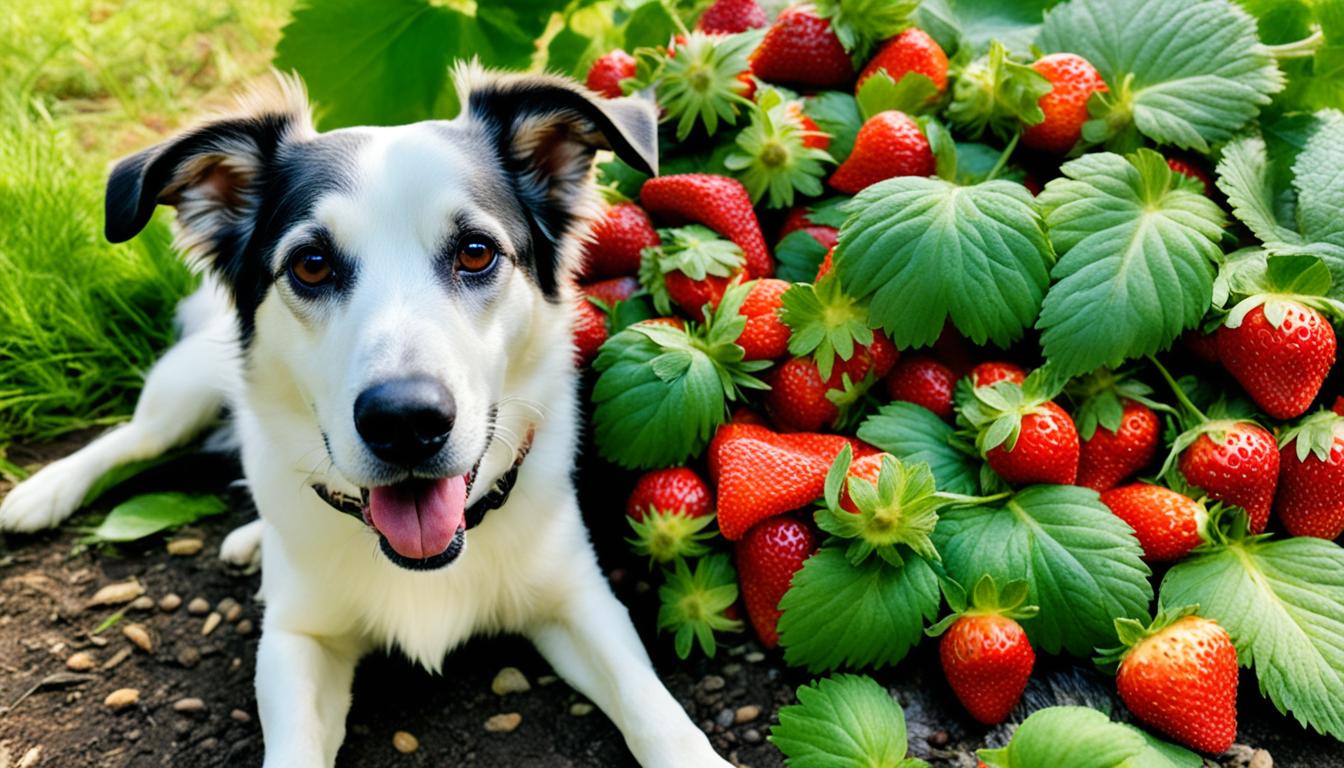Did you know that strawberries are not only a delicious treat for humans, but also a healthy option for dogs? Strawberries are rich in essential nutrients that can improve your furry friend’s health and well-being. However, before you start giving your dog strawberry snacks, there are some important things you should be aware of.
Key Takeaways:
- Strawberries are safe for dogs to consume in moderation.
- They are rich in antioxidants, vitamins, and minerals.
- Strawberries can promote a healthy immune system and aid in digestion.
- It’s important to follow safe consumption guidelines and be aware of potential risks.
- Consult with a veterinarian for personalized advice on incorporating strawberries into your dog’s diet.
Benefits of Strawberries for Dogs
When it comes to the health of our furry friends, incorporating nutritious foods into their diet is crucial. Strawberries are not only delicious for humans but can also bring a myriad of benefits to dogs. These vibrant red berries are packed with essential nutrients that promote overall wellbeing and support various bodily functions.

Here are some key health benefits that strawberries offer to dogs:
Promotes a Healthy Digestive System
Strawberries contain fiber, which plays a vital role in maintaining a healthy digestive system in dogs. Fiber aids in proper digestion and prevents common digestive issues such as constipation and diarrhea.
Supports the Immune System
Vitamin C is a powerful antioxidant found in strawberries that helps boost the immune system of dogs. This essential vitamin plays a key role in fighting off harmful pathogens and protecting against illnesses.
Reduces Inflammation
Strawberries are rich in antioxidants that help reduce inflammation in dogs. Inflammation can lead to various health issues and discomfort, so incorporating strawberries into their diet can have a positive impact on overall wellbeing.
Aids in Fluid Balance and Muscle Function
Potassium is a crucial mineral found in strawberries that aids in fluid balance and muscle function in dogs. It helps maintain proper hydration levels and supports healthy muscle contractions.
Contributes to Bone Development and Blood Clotting
Strawberries provide important nutrients for bone development and blood clotting in dogs. They are rich in calcium, iron, magnesium, phosphorus, and vitamin K, all of which play a role in maintaining healthy bones and ensuring proper blood clotting.
By incorporating strawberries into your dog’s diet, you can provide them with these essential nutrients and enjoy the numerous health benefits they offer. However, like any food, moderation is key. It’s always important to consult with a veterinarian before making any significant changes to your dog’s diet.
Potential Risks of Feeding Strawberries to Dogs
While strawberries are generally safe for dogs, it’s important to be aware of the potential risks associated with feeding them this delicious fruit. Here are some of the key risks and dangers to consider:
Choking Hazard:
Strawberries, especially whole ones, can pose a choking hazard for smaller dogs. To minimize this risk, it is essential to cut strawberries into small, bite-sized pieces before offering them to your furry friend.
Stomach Upset:
Natural sugars present in strawberries can cause gastrointestinal discomfort if consumed in excessive amounts. Dogs with sensitive stomachs or those prone to digestive issues may experience diarrhea, vomiting, or an upset stomach. It is best to feed strawberries in moderation, especially if your dog has any preexisting digestive conditions.
Pesticide Residues:
Unwashed strawberries may contain pesticide residues, which can be harmful to dogs if ingested. To minimize this risk, it’s recommended to thoroughly wash strawberries before feeding them to your pet. Opting for organic strawberries can also reduce the potential exposure to pesticides.
By being mindful of these potential risks and taking necessary precautions, you can safely incorporate strawberries into your dog’s diet and enjoy the many benefits they offer.
| Risks | Precautions |
|---|---|
| Choking Hazard | Cut strawberries into small pieces |
| Stomach Upset | Feed strawberries in moderation and monitor your dog’s response |
| Pesticide Residues | Thoroughly wash strawberries before feeding and consider organic options |

Note: Always consult with your veterinarian if you have any concerns or questions about feeding strawberries or any other food to your dog. Their professional guidance will help ensure the safety and well-being of your furry companion.
Safe Consumption Guidelines for Strawberries
When it comes to feeding strawberries to your furry friend, following safe consumption guidelines is essential. Here are some tips to ensure a positive and enjoyable experience:
- Offer strawberries in moderation: While strawberries provide health benefits, they should be given as a treat in moderation. Consider your dog’s size and dietary needs when determining the appropriate portion size.
- Rinse thoroughly: Before serving strawberries to your dog, make sure to rinse them thoroughly. This helps remove any dirt or potential chemicals that may be present on the surface.
- Cut into small pieces: To prevent choking hazards, it’s important to cut strawberries into small, bite-sized pieces. This ensures that your dog can safely enjoy this delicious fruit.
- Remove leaves and stem: While the leaves and stem of strawberries are not toxic to dogs, they can be tough to digest. It’s recommended to remove them before feeding strawberries to your furry companion.
- Consider frozen strawberries: Frozen strawberries can be a refreshing treat, especially during warmer months. They provide a cooling sensation and can serve as a great way to keep your dog hydrated.
- Mashed strawberries: Another way to incorporate strawberries into your dog’s diet is by mashing them and mixing them with their regular food. This can add a burst of flavor and nutrition to their meal.
By following these safe consumption guidelines, you can ensure that your dog enjoys strawberries in a safe and healthy manner.

“Offer strawberries in moderation, rinse thoroughly, cut into small pieces, remove leaves and stem, consider frozen strawberries, and try mashed strawberries as a topping.”
Can Dogs Eat Various Strawberry Items
When it comes to feeding strawberries to your furry friend, not all strawberry items are created equal. Let’s take a look at some common strawberry items and whether they are safe for dogs to consume:
Fresh Strawberries
Fresh strawberries are safe for dogs to eat in moderation. They are packed with nutrients like antioxidants, vitamins, and minerals that can benefit your dog’s health. However, it’s important to remember that strawberries should only make up a small portion of your dog’s overall diet.
Canned Strawberries
Canned strawberries, on the other hand, are not recommended for dogs. They often contain added sugars and preservatives, which can be harmful to your dog’s health. It’s best to stick to fresh strawberries to ensure your furry friend gets the most nutritional benefits without any unnecessary additives.
Strawberry Leaves
Strawberry leaves themselves are not toxic to dogs, but they may pose a choking hazard or cause digestive upset if ingested in large quantities. It’s advisable to remove the leaves before offering strawberries to your dog as a precaution.
Strawberry Yogurt and Ice Cream
While dogs can consume plain yogurt in moderation, strawberry yogurt and ice cream are not recommended. These products often contain high amounts of sugar and potentially harmful additives. Excessive sugar intake can lead to weight gain, dental issues, and other health problems in dogs. It’s best to avoid giving your dog strawberry yogurt or ice cream altogether.
In summary, fresh strawberries are a safe and nutritious treat for dogs when fed in moderation. However, it’s important to avoid canned strawberries, remove strawberry leaves, and steer clear of strawberry yogurt and ice cream due to added sugars and potential harmful additives. Stick to fresh or frozen strawberries without any added sugars or chemicals to ensure your dog can enjoy this tasty fruit while reaping the health benefits.

| Strawberry Item | Can Dogs Eat It? |
|---|---|
| Fresh Strawberries | Yes, in moderation |
| Canned Strawberries | No |
| Strawberry Leaves | No, remove before feeding |
| Strawberry Yogurt and Ice Cream | No |
Impact on Dog’s Health
Incorporating strawberries into a dog’s diet can have a positive impact on their health. The low-calorie content, antioxidants, and various nutrients contribute to overall well-being.
- Strawberries support the immune system and help protect against diseases and infections.
- They contain vitamin C, which acts as an antioxidant and helps reduce inflammation in the body.
- The high fiber content in strawberries promotes a healthy digestive system in dogs.
- Strawberries are a rich source of potassium, which aids in fluid balance and muscle function.
Additionally, strawberries provide essential vitamins and minerals that contribute to specific aspects of a dog’s health:
| Vitamins and Minerals | Benefits |
|---|---|
| Calcium | Supports bone development |
| Iron | Aids in oxygen transportation through the blood |
| Magnesium | Contributes to muscle and nerve function |
| Phosphorus | Helps with energy production and bone health |
| Vitamin K | Plays a role in blood clotting and maintaining pH balance |

In addition, strawberries can help with hydration due to their high water content. They provide a tasty and refreshing way for dogs to stay hydrated. The fun texture of strawberries also adds variety and enjoyment to their meals.
How to Introduce Strawberries to Dogs
When introducing strawberries to dogs, it’s important to follow a gradual approach to ensure their safety and well-being. By keeping a few key considerations in mind, you can make the experience enjoyable for both you and your furry friend.
Start with Small Quantities: Begin by offering your dog a small piece of strawberry to gauge their response. Monitor their behavior and digestive system for any adverse reactions. Every dog is unique, and some may have sensitivities or allergies. Observe them closely to ensure strawberries are well-tolerated.
Watching for Behavioral and Digestive Changes: Pay attention to any changes in your dog’s behavior or digestive functions after eating strawberries. Look out for signs of stomach upset, such as vomiting, diarrhea, or excessive gas. If you notice any adverse effects, discontinue feeding strawberries and consult with your veterinarian.
Thoroughly Washed Strawberries: Before feeding strawberries to your dog, make sure to wash them thoroughly to remove any dirt, pesticides, or potential chemical residues. This step eliminates any potential hazards and ensures that your dog only consumes clean and safe strawberries.
Safe and Digestible Pieces: To make strawberries easier for your dog to eat and digest, it is recommended to cut them into small pieces. This helps prevent choking hazards and allows for better digestion. Small pieces also make it easier to monitor the quantity of strawberries being consumed.

Gradual Incorporation: Just like with any new food, it is essential to introduce strawberries gradually into your dog’s diet. Start by offering them a small portion and assess their response. If there are no adverse effects, you can slowly increase the amount over time. This gradual approach allows your dog’s digestive system to adjust to strawberries and minimizes the risk of gastrointestinal issues.
By following these guidelines, you can introduce strawberries to your dog with confidence. Remember, every dog is different, and it’s important to monitor their individual response to ensure their well-being. Now that you know how to introduce strawberries to your furry friend, let’s explore some other considerations when feeding them this delicious fruit.
Limitations and Considerations
While strawberries can be a tasty addition to your dog’s diet, it’s essential to remember that they should only make up a small portion of their overall food intake. It’s important to consider the limitations and potential risks associated with feeding strawberries to dogs. Here are a few key considerations:
1. Treats should not exceed 10% of their daily calorie intake:
When giving your dog strawberries or any other treats, it’s crucial to keep moderation in mind. Treats, including strawberries, should only account for a small percentage (up to 10%) of their daily calorie intake. This ensures that their main meals meet their nutritional needs while treats remain just that—a special reward or occasional indulgence.
2. Dogs with specific dietary restrictions or health conditions:
Some dogs may have dietary restrictions or health conditions that require modified feeding guidelines. For example, if your dog has diabetes or is on a weight management plan, their strawberry consumption may need to be limited or monitored more closely. It’s always best to consult with a veterinarian to determine the appropriate amount of strawberries or other treats for your dog’s specific needs.
3. Potential digestive issues:
While strawberries are generally safe for dogs, they do contain natural sugars and fiber that can cause stomach upset if consumed in excessive amounts. If you notice any signs of digestive discomfort, such as diarrhea or vomiting, it may be a sign that your dog is not tolerating strawberries well. In such cases, it’s best to reduce or eliminate strawberry consumption and consult with a vet if the issues persist.
4. Pesticide residues and allergies:
Strawberries are part of the “Dirty Dozen” list of fruits and vegetables that are more likely to contain pesticide residue. It’s essential to thoroughly wash strawberries before feeding them to your dog, and consider choosing organic options when available. Additionally, like humans, dogs can be allergic to strawberries. If you notice any signs of an allergic reaction, such as itching, redness, or swelling, discontinue feeding strawberries and consult your veterinarian.
By considering these limitations and taking the necessary precautions, you can ensure that feeding strawberries to your dog remains a safe and enjoyable experience.

Other Fruity Treats for Dogs
In addition to strawberries, there are many other delicious and safe fruits that dogs can enjoy. Including a variety of fruits in your dog’s diet can provide them with essential nutrients and add some tasty variety to their meals. Here are a few examples of nutritious and dog-friendly fruits:
- Apples: Apples are a great source of vitamins A and C, as well as fiber. Remember to remove the seeds and core before offering them to your dog.
- Blueberries: Blueberries are rich in antioxidants and can contribute to your dog’s overall well-being. Serve them as an occasional treat or mix them into their food.
- Watermelon: Watermelon is a hydrating and refreshing fruit that dogs can enjoy. Remove the seeds and rind, and offer small pieces as a summer snack.
- Bananas: Bananas are packed with potassium and fiber. They can be a healthy and low-calorie treat for dogs. Just make sure to remove the peel before feeding.
When introducing these fruits to your dog, start with small portions to ensure they tolerate them well. Monitor their digestion and watch out for any allergic reactions. It’s important to do thorough research on each fruit to understand the potential benefits and risks before including them in your dog’s diet. Remember, moderation is key when it comes to feeding fruits to dogs.
“Adding a variety of fruits to your dog’s diet can provide them with essential nutrients and add some tasty variety to their meals.”
By offering your dog different types of safe fruits like apples, blueberries, watermelon, and bananas, you can provide them with a range of vitamins, minerals, and antioxidants. Experimenting with different fruits can also be a fun and enriching experience for your furry friend.

Conclusion
In conclusion, feeding strawberries to dogs can be a delightful and healthy addition to their diet when done responsibly. These vibrant fruits offer a range of nutritional benefits and can be a tasty treat for our canine companions. However, it is essential to adhere to safe consumption guidelines and take into account potential risks and individual dietary needs.
Strawberries provide dogs with valuable antioxidants, vitamins, and minerals that support their overall well-being. The fiber content aids in digestion, while vitamins C and K promote a robust immune system and bone health. By incorporating strawberries into their routine, dogs can enjoy improved hydration, healthy skin and coat, and a delightful texture to their meals.
Nevertheless, it is important to exercise caution when introducing strawberries to dogs. Small pieces should be provided to avoid choking hazards, and excess sugar consumption should be avoided to prevent stomach upset. Additionally, washing strawberries thoroughly and opting for organic options can reduce potential exposure to harmful pesticide residues.
Consulting with a veterinarian is always recommended to ensure individual needs and dietary restrictions are taken into account. Veterinarians can offer personalized advice and guidance on incorporating strawberries into a dog’s diet, ensuring optimal health and well-being.
Remember: Strawberries should be enjoyed in moderation as part of a balanced diet for dogs, and treats, including strawberries, should not exceed 10% of their daily calorie intake.
Final thoughts on strawberries for dogs
- Strawberries are a nutritious and delicious treat for dogs
- They offer antioxidants, vitamins, and minerals that support overall health
- Safe consumption guidelines should be followed, including washing thoroughly and cutting into small pieces
- Strawberries should be fed in moderation and should not exceed 10% of a dog’s daily calorie intake
- Always consult with a veterinarian for personalized advice and to consider individual dietary needs
By responsibly incorporating strawberries into a dog’s diet, we can provide them with a healthy and enjoyable snack that contributes to their overall well-being.
| Benefits of Feeding Strawberries to Dogs | Risks and Considerations | Safe Consumption Guidelines |
|---|---|---|
|
|
|

Next Article: Can Dogs Eat Turkey? When to Feed & When to Avoid
The next article will provide valuable insights into the topic of dogs eating turkey. We will explore whether it is safe to feed dogs this protein-rich meat and provide important information on when to feed it and when to avoid it. Our comprehensive guide will cover various considerations such as cooked or raw turkey, the safety of bones, and potential health risks associated with feeding dogs turkey.
Stay tuned for this informative article that will help you make informed decisions regarding your dog’s diet and ensure their health and well-being.

Newsletter Signup
Sign up for our free pet-parenting newsletters to receive expert advice and tailored articles for your beloved pet. At [Company Name], we understand that being a pet parent comes with its unique challenges and joys. That’s why our in-house team of professionals, including veterinarians and behaviorists, are here to provide you with valuable insights and support.
Our newsletters cover a wide range of topics, including pet care advice, behavior training, nutrition tips, health guidance, and much more. Whether you have a playful puppy, a curious kitten, or a loyal senior companion, our newsletters offer relevant and timely information to help you navigate the world of pet parenting with confidence and care.
In addition to helpful content, by signing up for our newsletters, you’ll also gain exclusive access to special discounts and offers from our trusted partner brands. We believe that every pet deserves the best care, and our newsletters are designed to empower you to give your furry friend a happy, healthy, and fulfilling life.
Join our newsletter community today and stay informed about the latest pet care trends, expert advice, and exciting promotions. Sign up now and become part of our thriving community of pet lovers!










